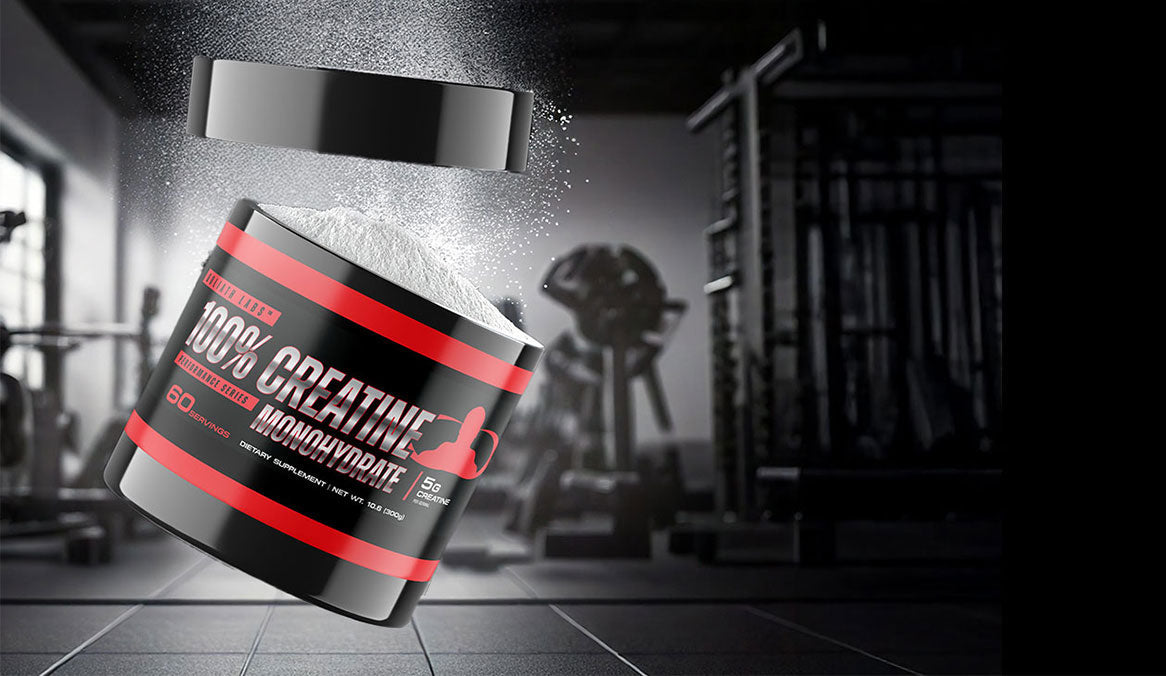Creatine remains one of the most rigorously studied and effective supplements for enhancing muscular energy, strength development, and recovery.
For beginners new to supplementation, understanding how to correctly use creatine powder can accelerate both short-term performance gains and long-term muscle health.
However, common mistakes, such as inconsistent intake, poor preparation methods, or timing misconceptions, can significantly blunt its effectiveness.
The good news is that properly using creatine is straightforward once the correct principles are in place.
In this guide, we will walk you through everything you need to know: the optimal dosing strategy, the best ways to mix and consume creatine powder, how to avoid pitfalls that limit absorption, and how to maximize the compound’s cellular benefits for better training results.
What Does Creatine Do and Who Is It For?
Creatine is a naturally occurring compound stored in muscle tissue, where it plays a critical role in energy production. During high-intensity activities like lifting, sprinting, or heavy labor, muscles rapidly deplete their primary energy molecule, adenosine triphosphate (ATP).
Supplementing with creatine increases phosphocreatine reserves, allowing the body to regenerate ATP more efficiently and sustain performance under stress.
This mechanism makes creatine uniquely valuable for anyone seeking to improve strength, endurance, or recovery.
While creatine supplementation is often associated with competitive athletes and bodybuilders, its benefits extend far beyond elite sports.
Beginners aiming to build a foundation of strength, busy adults managing fatigue, and retirees preserving muscle mass and mobility can all experience measurable improvements.
Clinical research consistently shows creatine’s support for cognitive health, injury recovery, and healthy aging, making it a practical tool across life stages.
Persistent myths continue to misrepresent creatine as a synthetic or steroid-like substance.
In reality, creatine is found naturally in foods like red meat and fish and is recognized as safe by leading health authorities worldwide. For healthy individuals, daily creatine supplementation poses no proven risks to kidney or liver function when used responsibly.
Finding Your Perfect Dose: How Much Creatine You Actually Need
While the process is straightforward, understanding your options, whether loading rapidly or building gradually, can help you tailor your strategy based on your goals and comfort level.
Should You Load Creatine or Start Slow?
The standard recommendation for creatine intake is 3 to 5 grams per day, providing steady saturation of muscle phosphocreatine stores within approximately three to four weeks.
This method minimizes the risk of digestive discomfort and supports gradual, sustainable gains in muscular energy and recovery capacity.
Alternatively, a loading phase involves taking 20 grams per day, divided into four or five doses, for five to seven days. Loading accelerates saturation, allowing some users to experience improvements in strength and endurance more quickly.
However, it also increases the chance of mild gastrointestinal side effects, such as bloating or cramping, particularly in sensitive individuals.
Long-term, there is no significant advantage to loading compared to consistent daily intake.
Both methods ultimately lead to similar results. Beginners and those with sensitive digestion often find that starting with a steady 3–5 gram daily dose provides the best combination of effectiveness and tolerability.
How to Handle Missed Days Without Worry
Missing a day of creatine supplementation does not significantly impact muscle saturation or long-term results.
Phosphocreatine levels in muscle tissue remain elevated for several days, even without continued intake. There is no need to double your dose or alter your routine to compensate. Simply resume your usual daily amount the following day.
Consistency over weeks and months determines success, not perfect daily compliance.
When Should You Take Creatine for Best Results?
While supplement timing is often treated as critical, creatine operates differently.
Scientific studies consistently show that the most important factor for creatine’s effectiveness is maintaining elevated muscle stores over time, not the precise moment it is consumed.
This means that “timing anxiety”, the worry about exactly when to take creatine, is largely unnecessary for achieving optimal results.
For convenience and habit formation, many users prefer taking creatine in the morning alongside breakfast, a multivitamin, or a protein shake.
Others incorporate it into their post-workout routine, when nutrient uptake may be slightly elevated. Both strategies are effective, but neither is required for creatine to perform its role in enhancing ATP regeneration and muscular endurance.
Ultimately, the best time to take creatine is the time you are most likely to remember consistently.
Whether your creatine comes with your morning coffee, your post-workout shake, or your evening meal, the physiological outcome remains the same: stronger muscles, faster recovery, and better long-term performance.
How to Actually Drink Creatine Without Gagging
Creatine powder is versatile, but preparation methods can make a noticeable difference in ease of use.
Warm or Cold? What Science Says
Creatine monohydrate dissolves more readily in warm liquids due to increased molecular activity at higher temperatures.
A glass of warm water or tea can help eliminate the gritty texture some users find unpleasant.
However, complete dissolution is not required for creatine to be absorbed efficiently. Cold water, while slower at dissolving creatine, remains perfectly effective.
Whether you prefer a warm or cold beverage, the physiological benefits are identical as long as the full dose is consumed.
The Shot Glass and Swirl Trick
For those who prefer speed and simplicity, the shot glass method provides an efficient solution.
Simply add your creatine dose to a small amount of warm or room-temperature water in a shot glass, swirl briefly, and drink it in one motion.
This minimizes the amount of liquid you need to consume and reduces the time creatine sits undissolved.
To ensure no residue is wasted, a second quick swirl with a little more water can capture any remaining powder. This approach is particularly convenient for busy mornings or post-workout rushes.
Can You Mix Creatine Into Coffee or Food?
Creatine can be mixed into coffee, but users should be aware that while absorption is unaffected, taste may suffer.
Some individuals report mild nausea when combining creatine with coffee, largely due to the bitterness and acidity of the drink rather than any chemical interaction.
For more palatable options, mixing creatine into smoothies, protein shakes, yogurt, or oatmeal offers practical solutions. Since creatine monohydrate is flavorless, it integrates easily into a variety of foods without altering taste or texture when properly blended.
We recommend integrating creatine into whatever daily habit ensures the highest consistency, whether that’s your morning shake, afternoon snack, or evening recovery meal.
Helpful Resource -> What NOT To Mix Creatine With
Avoiding Rookie Mistakes That Kill Your Progress
Successful creatine supplementation depends less on technical complexity and more on avoiding common beginner mistakes.
The first error many users encounter is inconsistency.
Skipping days and trying to "make up for it" later introduces unnecessary variability and delays full muscle saturation. Creatine works by maintaining elevated muscle stores over time, not by responding to sporadic high doses.
If you miss a day, simply resume your normal intake without adjustments.
Another common mistake is dry-scooping creatine, often promoted for its convenience.
While dry-scooping may seem harmless, it poses real risks, particularly for individuals with sensitive throats or a history of esophageal conditions. Creatine powder does not dissolve easily without liquid, increasing the likelihood of powder clumping in the throat, causing discomfort or potential aspiration.
Mixing creatine properly with water or another liquid remains the safest and most effective method.
Creatine does not produce immediate stimulation like caffeine or pre-workout supplements. Its benefits, enhanced muscle endurance, greater strength output, improved recovery, develop gradually as muscle phosphocreatine levels build over weeks of consistent use.
How Long Until You Feel Creatine Working?
Creatine is a compound that produces cumulative benefits rather than immediate sensations.
In the first week of consistent use, most users will not experience dramatic changes, as the body is still increasing intramuscular phosphocreatine stores.
By the second week, many individuals report subtle improvements in recovery between workouts, with reduced soreness and a faster return to training intensity.
By the third or fourth week, once full muscle saturation is achieved, the performance enhancements become more pronounced.
Users often notice greater muscular endurance during high-intensity sets, an ability to push further before reaching fatigue, and mild but visible increases in muscle fullness due to enhanced intracellular hydration.
It is critical to understand that creatine’s success is measured through improved training capacity and faster adaptation to workload, not through acute sensations or rapid bodyweight changes.
We encourage users to track strength progression, set volume, and recovery markers rather than relying on subjective feelings.
Making Your Creatine Work Even Harder: Small Tweaks, Big Results
Creatine is remarkably effective on its own, but small adjustments to your routine can optimize its absorption, comfort, and performance benefits.
These refinements are simple to implement and require no complicated strategies, just better understanding of how creatine interacts with your body’s physiology.
Stack It Smart: Creatine and Protein or Carbs
Creatine absorption into muscle tissue can be enhanced by mild insulin spikes following carbohydrate or protein intake.
Combining your creatine dose with a post-workout shake, a piece of fruit, or a small meal can modestly improve uptake efficiency without the need for excessive sugar consumption.
Research shows that moderate carbohydrate amounts, such as 20 to 30 grams, are sufficient to support creatine transport without introducing unnecessary caloric loads.
Goliath Labs recommends integrating creatine into your existing post-workout nutrition plan to streamline supplementation and maximize muscle recovery.
Micronized Creatine vs. Regular: Worth It?
Micronized creatine undergoes additional processing to reduce particle size, improving its solubility and reducing the gritty texture often associated with traditional powders.
For individuals who experience minor digestive discomfort with standard creatine monohydrate, switching to a micronized version can significantly enhance gastrointestinal comfort and mixing ease without altering the supplement’s effectiveness.
Why Water Matters (But Not as Much as You Think)
While creatine increases water retention within muscle cells to enhance hydration and fullness, it does not require extreme water intake to be effective.
Drinking according to thirst cues remains sufficient for most users.
There is no scientific justification for the gallon-per-day protocols sometimes promoted in fitness culture.
Excessive water intake without need can dilute electrolytes and introduce unnecessary risk. Maintaining balanced hydration through regular fluid consumption, especially around workouts, is enough to complement creatine’s natural effects on muscular performance and recovery.
Take Your Creatine Powder Consistently
Creatine delivers exceptional results through consistency, not complexity.
Building stronger muscles, recovering faster, and performing at a higher level are outcomes earned through small, daily actions, not by chasing perfect conditions or overthinking the process.
Investing five minutes a day to take your creatine properly can create measurable improvements in strength, endurance, and long-term muscle health.
Choosing a trusted, clean source matters. Whether you are beginning your fitness journey or refining your performance strategy, reliable supplementation is a cornerstone of lasting progress.
Explore Goliath Labs’ full range of proven products and experience how straightforward, science-backed habits can transform your training outcomes



